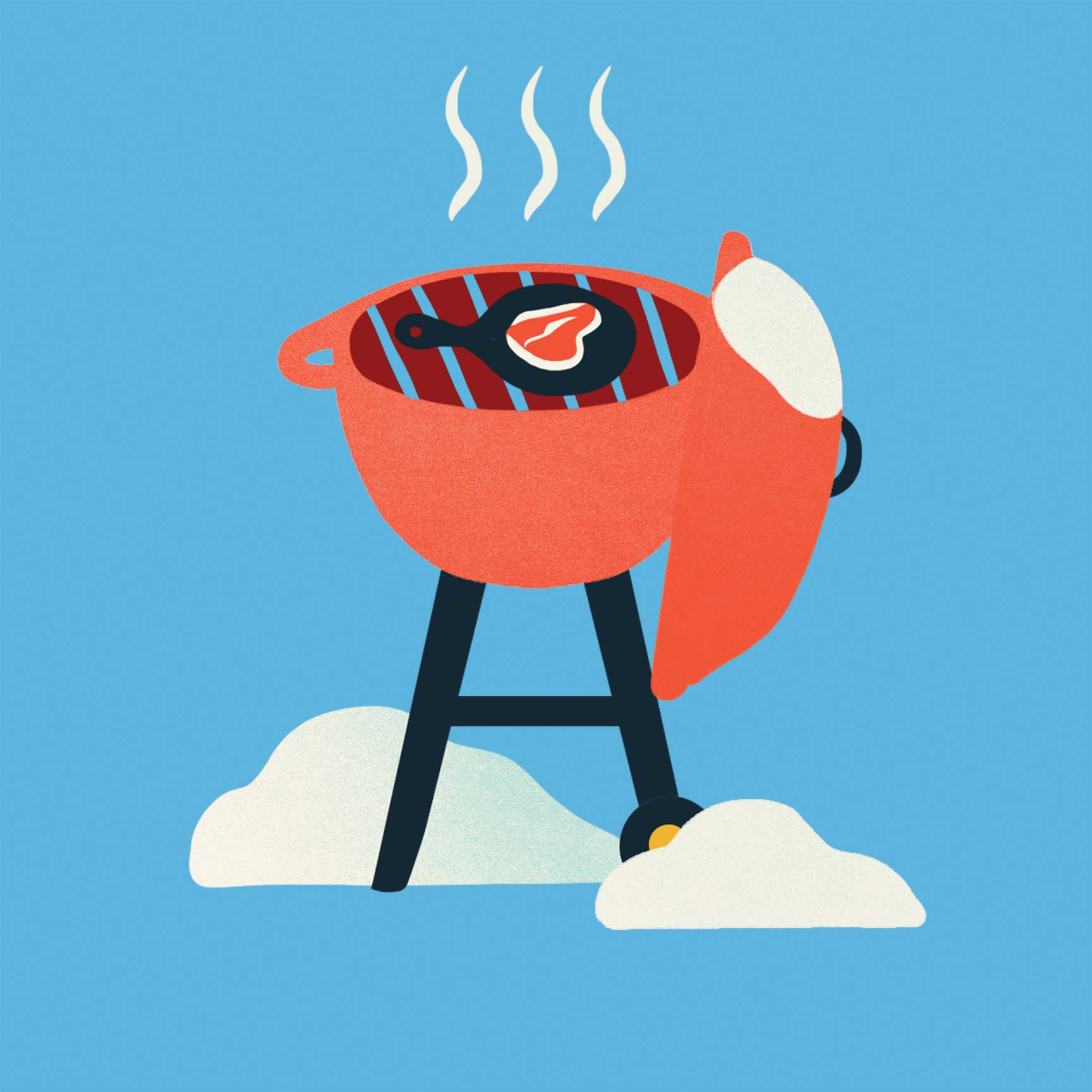Backyard Porterhouse Steak With Winter Herb Chimichurri
Kevin Hickey, the Duck Inn
Serves:2
“To cook outdoors, I use a turkey fryer — you can find one for $40 — and place a cast-iron skillet on its propane-fueled burner. Most people don’t have backyard grills that can get ripping hot, but this will, and you can quickly do an amazing steak. Plus, you can just toss the leftover grease in the snow.”
| 1 bunch | Parsley |
| 1 sprig | Winter savory (an evergreen herb) |
| 2 sprigs | Thyme |
| 2 sprigs | Tarragon |
| 1 sprig | Rosemary |
| 1 cup | Extra virgin olive oil |
| 2 cloves | Garlic |
| 1 | Fresno chile |
| 2 Tbsp. | Red wine vinegar |
| 1 Tbsp. | Kosher salt, plus more for steak |
| 1 | Lemon, juiced |
| 1 | 18–24 oz. porterhouse steak, brought to room temperature and patted dry |
| Freshly cracked black pepper | |
| 4 oz. | Safflower oil or other high-smoke-point oil |
| 1 Tbsp. | Butter |
| Sea salt, for serving |
1. Make the chimichurri by adding first 11 ingredients to a blender and blending until smooth. Set aside.
2. Season steak liberally with salt and pepper. Heat a cast-iron skillet over the turkey fryer burner’s highest setting for 3 minutes, then reduce heat to medium-high. Add oil and heat for 30 seconds. Sear steak until a crust has formed, about 2 minutes, then flip and sear other side. Continue to turn the steak until you reach desired temperature, about 5 minutes total for medium-rare.
3. Remove steak from heat and slather with butter. Let rest indoors for 10 minutes before separating meat sections from bone and slicing them. Arrange sliced steak on a platter with the bone, sprinkle with sea salt, and drizzle with the chimichurri.
Cold-Smoked Salmon Spread
Brian Bruns, Flat & Point
Makes:2 cups
“Keeping fire alive in the cold is challenging, but keeping smoke alive is no problem. Cold smoking is typically done as a preservation technique at a smokehouse, but you can use what you have — a charcoal or gas grill works — as long as it has a cover.”
| 2 Tbsp. | Sugar |
| 2 Tbsp. | Salt, plus more to taste |
| 2 Tbsp. | Riesling |
| Red pepper flakes | |
| 2½ lb. | Salmon fillets |
| ½ lb. | Cream cheese |
| 2 Tbsp. | Scallions |
| 1 sprig | Dill |
| Black pepper | |
| Caraway seeds and chopped capers (optional) |
1. Cure the fish by mixing first four ingredients in a bowl, then rubbing mixture all over the salmon. Place salmon in a resealable plastic bag along with any extra cure mixture. Press out as much air as possible and seal. Refrigerate for 3 days.
2. One day prior to cold smoking, remove salmon from bag, rinse under cold water, and pat dry with paper towel. Let fish air-dry
on a wire rack in refrigerator overnight.
3. To smoke fish, fill a small foil pan with wood chips. Light one charcoal briquette and place it in the pan. Cover pan with aluminum foil, poke five holes into the top, and set pan on clean grill rack. Place the fish on the rack next to the foil pan, then cover the grill.
4. Check briquette and wood chips every 45 minutes or so, replacing briquette and chips once they’re almost burnt out. Repeat for 4 to 6 hours (there’s no set smoking time, but the meat takes on more flavor the longer you smoke it). Once smoked, let the fish rest in the refrigerator uncovered overnight so that the flavors can develop.
5. Make the spread: In a food processor, blend ½ pound of the smoked salmon with the cream cheese, scallions, dill, and salt and pepper to taste until smooth. (You can freeze the rest of the smoked salmon for up to a year, or refrigerate it, sealed in plastic wrap, for up to 10 days.) Flavor the mixture with a pinch or two of caraway seeds and chopped capers if you like. Spread can be stored for up to 2 weeks in the refrigerator.



